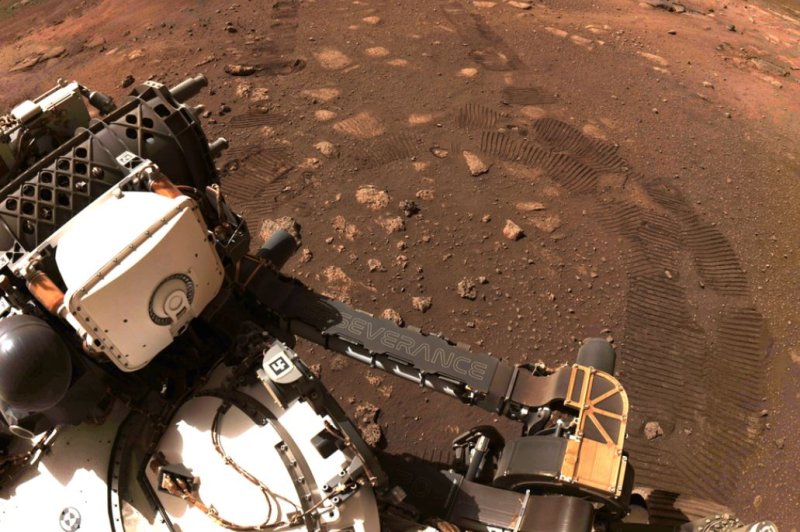1 of 3 | This image was taken during the first drive of NASA’s Perseverance rover Thursday as engineers checked out the rover's systems following its landing in Jezero Crater on February 18. Photo courtesy of NASA
ORLANDO, Fla., March 5 (UPI) -- NASA's new Mars rover Perseverance made its first short drive on the Red Planet and took images of its own wheel marks in the Martian dust, agency engineers said Friday.
The rover drove about 21 feet Thursday and used its steering function, performing better than it did on Earth said Anais Zarifian, a Perseverance mobility engineer for NASA, said in a news briefing.
"Our first drive went incredibly well," Zarifian said. "You can see the wheel tracks that we left on Mars. I don't think I've ever been happier to see wheel tracks that I've seen a lot."
Perseverance creeps along at about the same speed as NASA's previous rover, Curiosity, which still is functioning on Mars, at about .01 mph, Zarifian said. The new rover landed on the planet Feb. 18 in an area named Jezero Crater.
But Perservance's systems allow it to move farther in a given day because it can robotically avoid hazards like big rocks and sand traps.
"We'll have less time planning drives and down time, and more time to do science," she said.
Engineers said they installed new surface software and successfully checked out nearly every system and subsystem on the rover to prepare it for its primary mission -- drilling rocks for evidence of ancient life on Mars.
The rover also spotted a rock outcropping of high interest to NASA scientists, about 1 1/2 miles away and about 33 feet high, said Katie Stack Morgan, a NASA deputy project scientist on the mission.
"These rocks look noticeably different, in that you can actually [see] layers within the rocks ... likely deposited by rivers flowing into the ancient lake" at Jezero Crater, Stack Morgan said.
NASA's science and engineering teams are working together to choose the best route to investigate the river deltas, she said. A final decision on the route probably won't be made until Perseverance's helicopter, Ingenuity, flies and scopes out the region, she said.
"Before we can think about exploring the Jezero delta, we have to figure out how to get the rover in there," Stack Morgan said.
The rover's scheduled timeline on the Red Planet is about two Earth years, but most of its systems are expected to last much longer. The rover was launched from Kennedy Space Center in Florida in July.
NASA's Perseverance Mars rover, using its Mastcam-Z camera system, captured this view of the Martian sunset on November 9, 2021, the 257th Martian day, or sol, of the mission. Martian sunsets typically stand out for their distinctive blue color as fine dust in the atmosphere permits blue light to penetrate the atmosphere more efficiently than colors with longer wavelengths. But this sunset looks different: Less dust in the atmosphere resulted in a more muted color than average. The color has been calibrated and white-balanced to remove camera artifacts. Photo courtesy of NASA |
License Photo
















